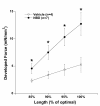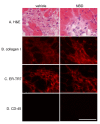Improvement of cardiac contractile function by peptide-based inhibition of NF-κB in the utrophin/dystrophin-deficient murine model of muscular dystrophy
- PMID: 21586145
- PMCID: PMC3212940
- DOI: 10.1186/1479-5876-9-68
Improvement of cardiac contractile function by peptide-based inhibition of NF-κB in the utrophin/dystrophin-deficient murine model of muscular dystrophy
Abstract
Background: Duchenne muscular dystrophy (DMD) is an inherited and progressive disease causing striated muscle deterioration. Patients in their twenties generally die from either respiratory or cardiac failure. In order to improve the lifespan and quality of life of DMD patients, it is important to prevent or reverse the progressive loss of contractile function of the heart. Recent studies by our labs have shown that the peptide NBD (Nemo Binding Domain), targeted at blunting Nuclear Factor κB (NF-κB) signaling, reduces inflammation, enhances myofiber regeneration, and improves contractile deficits in the diaphragm in dystrophin-deficient mdx mice.
Methods: To assess whether cardiac function in addition to diaphragm function can be improved, we investigated physiological and histological parameters of cardiac muscle in mice deficient for both dystrophin and its homolog utrophin (double knockout = dko) mice treated with NBD peptide. These dko mice show classic pathophysiological hallmarks of heart failure, including myocyte degeneration, an impaired force-frequency response and a severely blunted β-adrenergic response. Cardiac contractile function at baseline and frequencies and pre-loads throughout the in vivo range as well as β-adrenergic reserve was measured in isolated cardiac muscle preparations. In addition, we studied histopathological and inflammatory markers in these mice.
Results: At baseline conditions, active force development in cardiac muscles from NBD treated dko mice was more than double that of vehicle-treated dko mice. NBD treatment also significantly improved frequency-dependent behavior of the muscles. The increase in force in NBD-treated dko muscles to β-adrenergic stimulation was robustly restored compared to vehicle-treated mice. However, histological features, including collagen content and inflammatory markers were not significantly different between NBD-treated and vehicle-treated dko mice.
Conclusions: We conclude that NBD can significantly improve cardiac contractile dysfunction in the dko mouse model of DMD and may thus provide a novel therapeutic treatment for heart failure.
Figures







Similar articles
-
Utrophin deficiency worsens cardiac contractile dysfunction present in dystrophin-deficient mdx mice.Am J Physiol Heart Circ Physiol. 2005 Dec;289(6):H2373-8. doi: 10.1152/ajpheart.00448.2005. Epub 2005 Jul 15. Am J Physiol Heart Circ Physiol. 2005. PMID: 16024571
-
Diaphragm rescue alone prevents heart dysfunction in dystrophic mice.Hum Mol Genet. 2011 Feb 1;20(3):413-21. doi: 10.1093/hmg/ddq477. Epub 2010 Nov 9. Hum Mol Genet. 2011. PMID: 21062902
-
Increased constitutive nitric oxide production by whole body periodic acceleration ameliorates alterations in cardiomyocytes associated with utrophin/dystrophin deficiency.J Mol Cell Cardiol. 2017 Jul;108:149-157. doi: 10.1016/j.yjmcc.2017.06.004. Epub 2017 Jun 13. J Mol Cell Cardiol. 2017. PMID: 28623080
-
Current Translational Research and Murine Models For Duchenne Muscular Dystrophy.J Neuromuscul Dis. 2016 Mar 3;3(1):29-48. doi: 10.3233/JND-150113. J Neuromuscul Dis. 2016. PMID: 27854202 Free PMC article. Review.
-
Contribution of oxidative stress to pathology in diaphragm and limb muscles with Duchenne muscular dystrophy.J Muscle Res Cell Motil. 2013 Feb;34(1):1-13. doi: 10.1007/s10974-012-9330-9. Epub 2012 Oct 28. J Muscle Res Cell Motil. 2013. PMID: 23104273 Review.
Cited by
-
Cell-type specific penetrating peptides: therapeutic promises and challenges.Molecules. 2015 Jul 20;20(7):13055-70. doi: 10.3390/molecules200713055. Molecules. 2015. PMID: 26205050 Free PMC article. Review.
-
Small mammalian animal models of heart disease.Am J Cardiovasc Dis. 2016 Sep 15;6(3):70-80. eCollection 2016. Am J Cardiovasc Dis. 2016. PMID: 27679742 Free PMC article. Review.
-
Pharmacologic management of Duchenne muscular dystrophy: target identification and preclinical trials.ILAR J. 2014;55(1):119-49. doi: 10.1093/ilar/ilu011. ILAR J. 2014. PMID: 24936034 Free PMC article. Review.
-
Wasting mechanisms in muscular dystrophy.Int J Biochem Cell Biol. 2013 Oct;45(10):2266-79. doi: 10.1016/j.biocel.2013.05.001. Epub 2013 May 11. Int J Biochem Cell Biol. 2013. PMID: 23669245 Free PMC article. Review.
-
Cardiomyopathy in Duchenne Muscular Dystrophy and the Potential for Mitochondrial Therapeutics to Improve Treatment Response.Cells. 2024 Jul 9;13(14):1168. doi: 10.3390/cells13141168. Cells. 2024. PMID: 39056750 Free PMC article. Review.
References
-
- Blake DJ, Weir A, Newey SE, Davies KE. Function and genetics of dystrophin and dystrophin-related proteins in muscle. Physiol Rev. 2002;82:291–329. - PubMed
-
- Acharyya S, Villalta SA, Bakkar N, Bupha-Intr T, Janssen PML, Carathers M, Li ZW, Beg AA, Ghosh S, Sahenk Z, Weinstein M, Gardner KL, Rafael-Fortney JA, Karin M, Tidball JG, Baldwin AS, Guttridge DC. Interplay of IKK/NF-kappaB signaling in macrophages and myofibers promotes muscle degeneration in Duchenne muscular dystrophy. J Clin Invest. 2007;117:889–901. doi: 10.1172/JCI30556. - DOI - PMC - PubMed
Publication types
MeSH terms
Substances
Grants and funding
LinkOut - more resources
Full Text Sources
Other Literature Sources
Miscellaneous

